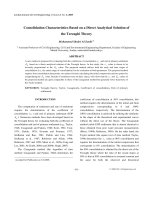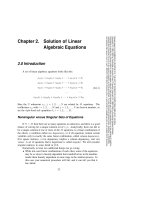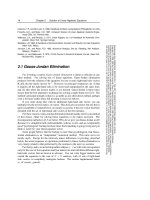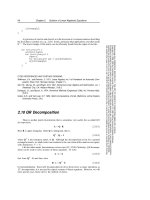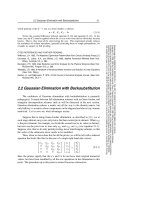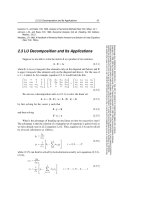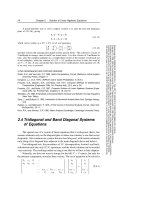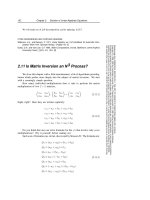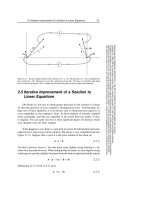- Trang chủ >>
- Khoa Học Tự Nhiên >>
- Vật lý
Solution of Optics-Modern-Physics-2E-Sol--DC-Pandey
Bạn đang xem bản rút gọn của tài liệu. Xem và tải ngay bản đầy đủ của tài liệu tại đây (1.94 MB, 99 trang )
Solutions
of
Optics &
Modern Physics
Lesson 26th to 30th
By DC Pandey
26. Reflection of Light
Introductory Exercise 26.1
1
where c is the speed of light
m 0 e0
1
in vacuum hence unit of
is m/s.
m 0 e0
w = 1.5 ¥ 1011 rad/s
1. Since c =
2. Hence
-7
11
By = 2 ¥ 10 T sin [500x + 1.5 ¥ 10 t ]
Comparing this equation with the standard
wave eqution By = B0 sin [ kx + w t ]
2p
k = 500 m -1 fi k =
l
2p
m
fi
l=
k
2p
p
m=
metre
fi
l=
500
250
fi
fi
2 pn = 1.5 ¥ 1011
1.5
n=
¥ 1011 Hz
2p
Speed of the wave v =
w 1.5 ¥ 1011
=
k
500
= 3 ¥ 108 m/s
Let E0 be the amplitude of electric field.
Then E0 = cB0 = 3 ¥ 108 ¥ 2 ¥ 10-7
= 60 V/m
Since wave is propagating along x-axis and
B along y-axis, hence E must be along z-axis
fi E = 60 V/m sin [500x + 1.5 ¥ 1011 t ]
Introductory Exercise 26.2
1. Total deviation produced
From figure
q = 90∞ - i
1
fi
i
i
180
°–2
i
N1
= 180∞
90°
90°
d = 360∞ - 2 [ i + 90 - i]
2
90°
q q
2. v0 = 2 m/s for plane mirror vi = 2 m/s.
180°–2q
N2
d = 180∞ - 2 i + 180∞ - 2q
d = 360∞ - 2( i + q)
Hence rays 1 and 2 are parallel (antiparallel).
Velocity of approach = v0 + vi = 4 m/s.
3. In figure, AB is mirror, G is ground, CD is
pole and M is the man. The minimum height
to see the image of top of pole is = EN
2
q
L
A
N
2m
K
N1
M
C
E
tan f =
q
pole
=4m
2m
D
f
8m
L'
f
f
2m
B
C' 6 m
f = 45∞
So, NK = 4 ¥ tan 45∞ = 4 m
Hence in minimum height
= 6 m + 4 m = 10 m
In
DAC¢ C
tan q =
C
= EK + KN = 6 + KN
Now in DNKB,
NK
= tan f fi NK = KB tan f
KB
4
=2
2
In DL¢ LA we get,
LL¢
= tan q
LA
LL¢
fi
=2
4
LL¢ = 8 m
fi
= 4 tan f
BC¢ 2
= =1
CC¢ 2
Maximum height = CA + LL¢ = 8 + 8 = 16 m
In DBC¢ C we get,
Introductory Exercise 26.3
1. Here f = - 10 cm (concave mirror)
(a) u = - 25 cm
Using mirror formula,
1 1 1
+ =
v u f
fi
fi
fi
1 1 1
1
1
= - =+
v f u
10 25
1 -5 + 2
=
v
50
50
v== - 167
. cm
3
Hence image is real, inverted and less
height of the object.
(b) Since u = - 10 cm,
Hence object is situated on focus of the
image formed at •.
(c) u - 5, f = - 10
1 1 1
1 1
= - =+
v f u
10 5
fi
1 -1 + 2
=
v
10
fi
v = 10 cm
Hence, image is virtual, erect and two time
of the object.
1
2. Here u = - 3 m, f = - m,
2
we have,
1 1 1
(a) = v f u
fi
1
1
= -2 +
v
3
fi
v = - 0.6 m
As ball moves towards focus the image
moves towards -• and image is real as the
distance decreases by focal length image
become virtual which moves from + • to
zero.
(b) The image of the ball coincide with ball,
when u = - R = - 1 m
3
Using h = ut +
fi
t=
1 2
gt
2
4. Since the incident rays and reflected rays
are parallel to each other therefore mirror is
plane mirror.
2¥ 2
2h
=
g
9.8
5. Let us solve the first case :
= 0.639 s
Similarly again images match at t = 0.78 s.
3. Since image is magnified, hence the mirror
is concave.
-v
-v
Here,
m=
fi
=5
u
u
fi
v = -5u
A
Since image is formed at a distance 5 m
from mirror
…(ii)
From Eqs.(i) and (ii), we get
- (5 + x) = - 5x
fi
4x = 5
fi
x = 1.25
Hence mirror is placed at 1.25 m on right
side of the object by mirror formula
1 1 1
+ = ,
v u f
we have
1
1
1
=f
6.25 1.25
fi
f =
- 6.25
,
6
Hence R = 2 f fi R = -
a
a
a
A'
q
2q
F
q
C
…(i)
Let distance between mirror and object is x.
v = - (5 + x)
q M
q
B
40 cm
20 cm
By applying the geometry we can prove that,
40
PA¢ = v =
cm
3
Further, in triangles ABP and PA¢ B¢ we
have,
AB
A¢ B¢
=
40 ( 40/ 3)
\
Thus mirror is concave mirror of radius of
curvature 2.08 m.
A¢ B¢ =
AB 2
= cm
3
3
Similary, we can solve other parts also.
6. Simply apply :
1 1 1
= =
v u f
I -v
for lateral magnification. If
=
o u
magnitfication is positive, image will be
virtual. If magnification is negative, image
will be real.
and m =
6.25
= - 2.08 m
3
20 cm
4
AIEEE Corner
¢
Subjective Questions (Level 1)
Hence the images distance are 2 nb, where
n = 1, 2, K . Ans.
1. Here v = 39.2 cm, hence v = - 39.2 cm
and magnification m = 1
fi
hi = ho = 4.85
Hence image is formed at 39.2 cm behind
the mirror and height of image is = 4.85 cm.
5. Suppose mirror is rotated at angle q about
its axis perpendicular to both the incident
ray and normal as shown in figure
y
2. From figure, angle of incident = 15∞
N
0°
i
Mirror
x
q
Horizontal
(a)
15°
15°
y
IV
Let reflected ray makes an angle q with the
horizontal, then
i–2q
I
A
R'
i–q q i–q
q + 15∞ + 15∞ = 90∞ fi q = 60∞
3.
i
°
15
R
N
Incident ray
1 50
Reflacted ray
90°
I
C
x
q
(b)
O'
1o cm
30 cm
50 cm
B
1o cm
O''
30 cm
O'''
50 cm
O'''
70 cm
In figure (b) I remain unchanged N and R
shift to N¢ and R¢.
From figure (a) angle of rotation = i,
D
40 cm
Since mirror are parallel to each other •
image are formed the distance of five closet
to object are 20 cm, 60 cm, 80 cm, 100 cm and
140 cm.
From figure (b) it is i - 2q
Thus, reflected ray has been rotated by
angle 2q.
6. I is incident ray –i = 30∞ = –r
4. The distance of the object from images are
2b, 4 b, 6b..... etc.
30°
C
30°
A
1.6m
A
2b
20 cm
R
O'''
b
O''
b
O'
b
O'''
I
A'
4b
1
4b
B
x
P
From D PA¢ A, we get
D
B
B'
5
x
= tan 30∞ fi x = 20 tan 30∞
20
160 cm
AB
No. of reflection =
=
x
20 cm Ơ tan 30
= 8 3 ê 14
Hence the reflected ray reach other end
after 14 reflections.
7. The deviation produced by mirror M1 is
= 180∞ - 2 a
M1
Z'
I1
a
180°–2a
R2
90°–a a
R1 f f
90°–f
180°–2q
q
A
C
and the deviation produced by mirror M2 is
= 180 - 2
Hence total deviation
= 180 - 2a + 180 - 2f
= 360 - 2 ( a + f)
Using mirror formula,
fi
1 1 1
= v f u
fi
- 165 + 11
1
1
1
=+
=
v
11 16.5 16.5 ¥ 11
fi
v=-
Hence size of image is hi = 2 ¥ h0
= 2 ¥ 6 = 12 mm.
R
9. Here u = - 12 cm, f = + = + 10 cm
2
Using mirror formula
1 1 1
+ =
v u f
we get
1 1 1 1
1
= - =
+
v f u 10 12
90 - a + q + 90 - f = 180
Object height h0 = 6 mm
u = - 16.5 cm
(a) The ray diagram is shown in figure
B
A'
A
fi
The image is formed on right side of the
60
vertex at a distance
cm. the image is
11
virtual and erect the absolute magnification
v
is given by |m|=Ω Ω
Ω uΩ
fi
f
B' u = 16.5 cm
6+5
60
60
cm = 5.46 cm
v=
11
=
a + f=q
Hence deviation produces = 180 - 2q.
R
22
8. Here f = - = = - 11 cm
2
2
16.5 ¥ 11
= - 33 cm
5.5
Hence the image is formed at 33 cm from the
pole (vertex) of mirror on the object side the
image is real, inverted and magnified. The
absolute magnification
v
33
|m|=Ω Ω =
=2
Ω uΩ 16.5
In D ABC we get,
fi
1 1 1
+ =
v u f
Q
Ω
Ω 5
60
Ω=
|m|=Ω
Ω 11 ¥ ( - 12) Ω 11
m <1
Hence image is de-magnified.
Height of image hi =|m|¥ h0
6
fi hi =
5
45
¥9=
= 4.09 mm
11
11
The ray diagram is shown in figure
B
B'
A 12 cm
(O)
A'
5/11cm
F
10. Here f = - 18 cm
Let distance of object from vertex of concave
mirror is u. Since image is real hence image
and object lie left side of the vertex.
v 1
Magnification m = - =
u 9
u
fi
v=9
1 1 1
By mirror formula, + = , we have
v u f
-
1
1
1
10
1
fi - ==u/9 u
18
u
18
fi u = 180 cm (left side of the vertex).
11. Here u = - 30 cm, since image is inverted.
Hence the mirror is concave.
1 -v
u
m= =
fi v=2 u
2
1 1 1
Using mirror formula, + = , we get
v u f
fi
-3 1
2 1 1
fi
=
- =
u
f
u u f
fi
v =3 ¥ u
fi
v = 3u and v is +ve
By mirror formula,
1 1 1
1 1 1
+ = fi
- v u f
3u u 12
1 -3
1
fi
=fi u = 8 cm
3u
12
(b) Since image is real
v
fi
m = - = 3 fi v = - 3u
u
1 1 1
By using + = , we get
v u f
-4
1 1
1
1
fi
=- - =3u
12
e u
12
u = 16 cm
-v 1
u
(c) Here m =
= fiv=m 3
3
1
1
1
fi
- =u/3 u
12
fi
4
1
fi u = 48 cm
=u
12
1 1 1
13. We have + =
v u f
fi
fi v=
(a) Since image is virtual
v
fi
fi v = mu
m=
u
uf
at u = f , v = •
u-f
The variation is shown in figure
v(m)
0.5
0.25
u(m)
u
30
f =- == - 10 cm
3
3
Hence mirror is concave of focal length
10 cm.
24
12. Here f = cm = - 12 cm
2
-
0.25
0.5
Hence focal length if assymtote of the curve.
When u < f , Image is virtual. It means v is
negative.
When
u = 2f
v = 2f
u Ỉ 0, v Ỉ 0
7
14. Here f = 21 cm fi R = 2 f = 42 cm
Since the object is placed on C. Hence its
image by concave mirror is formed on C. This
image acts as a virtual objet for plane mirror
the distance between plane mirror and
virtual object = 21 cm.
Hence plane mirror forms its real image in
front of plane mirror at 12 cm.
15. Let u is the object distance from vertex, v is
the image distance for vertex and f is the
focal length then distance between object
and focus is u - f and distance between
image and focus is v - f ie,
(u - f ) (v - f ) = uv - (u + v) f + f 2
1 1 1
Using
+ + , we get
v u f
…(i)
1 1 2
xR
fi v=
- =
v x 12
2x + R
For concave mirror
È2R2 + 5xR ˘
È
xR ˘
u¢ = - Í2R +
=
2x + R
ẻ
ẻ 2x + R
R
v = - (2R - x) and f ¢ = 2
1 1 1
Using +
= , we get
v¢ u¢ f ¢
-
(2x + R)
1
2
(2R - x) (2R2 + 5xR) R
4 R 3 - 2x2 R + 8 xR2
…(ii)
fi
Putting the value of uv in RHS of Eq. (i), we
get
fi
4 R 3 + 8 xR2 - 8 x2 R = 0
(u - f )(u - f ) = (v + u) f - (v + u) f + f 2
fi
4 R[ R2 + 2xR - 2x2 ] = 0
(u - f )(v - f ) = f 2
fi
2x2 - 2xR - R2 = 0
Q
Rπ0
fi
x=
fi
Ê1 + 3 ˆ
˜R
x = ÁÁ
˜
Ë 2 ¯
uv = (u + v) f
Hence proved.
16. Let object is placed at a distance x from the
convex mirror then for convex mirror
R
u - x and f = +
2
¢
Let v be the distance of the image from pole
(vertex) of convex mirror.
1 1 1
Using
+ = , we get
v u f
= 8 R 3 + 16xR2 - 10x2 R
2R ± 2 3 R [1 ± 3 ]
=
R
4
2
Objective Questions (Level 1)
1. When convergent beam incident on a plane
mirror, then mirror forms real image
Plane mirror
I
O
Virtual object
2. When an object lies at the focus of a concave
mirror u = - f focal length of a concave
mirror is negative.
Using mirror formula
1 1 1
+ =
v u f
we get,
1 1
1
- =- fiv=•
v f
f
8
also magnification m = -
v
= •.
u
6. From figure
1
Hence, correct option is (c) •, •.
2
3. Total deviation, d = d1 + d2
–q
9 0°
q
q
q
q
N1
70°
180° 2q
a a
70°
20° + q
180°–2a
20 + q = 70∞
q = 70∞ - 20∞
N2
q = 50∞
= 180 - 2q + 180 - 2a
but
a = 90 - q
Here (1) and (2) are paralledl 11 to each
other.
fi
d = 180 - 2q + 180 - 2 (90 - q)
Hence the correct option is (a) = 50∞.
fi
d = 180∞
7. The radius of curvature of convex mirror
Hence, option (a) is correct.
4. A concave mirror cannot from a virtual
image of a virtual object.
Hence option (a) is correct.
5. For a concave mirror for normal sign
convention if u = - f fi v = •
and
at u = - •, v = - f
graph between u and v is
v
u
R = + 60 cm.
R
Its focal length f = = + 30 cm
2
v 1
Magnification m = =
u 2
u
fi
v=
2
1 1 1
Using mirror formula, + = ,
v u f
1
1 1
- =
u / 2 u 30
we get,
-
fi
-3 1
=
u
30
fi
u = - 90 cm
u
v = = - 45 cm
2
Hence distance between A and B is
The dotted lines are the asymptotes
(tangent at •) of the curve.
Hence correct option is (b).
= 90 - 45
= 45 cm
Hence the correct option is (c).
9
8. Here it is given that height of the boy
HF = 1.5 m
H
Using mirror formula, we get
1 1 1
+ =
v u f
A
0.1 m C
E
-
Mirror
fi
1.5m
K
B
fi
1 1 1
- =
3u u f
-3u
4
- 3 ¥ 40
f =
= - 30 cm
2
f =
Mirror is concave and focal length is 30 cm.
F
D
Length of mirror = AB = 0.75 m
The ray diagram is shown in above figure.
H is the Head of the boy and F is the feet. It
also shows the paths of the rays that leaves
the head of the man enter his eyes (E). After
reflection from the mirror at point A, and
the rays that leave his feet and enter his
eyes after reflected at point B.
1
From figure CE = HE = 0.05 m
2
CF = HF - HC = HF = CE
= 1.50 - 0.05 = 1.45 m
Correct option is (a).
1
v
10. Here m = + = n
u
u
fi
v=n
we get,
1
1
1
=
+
f ( - u / n) u
fi
= 1.45 - 0.75 = 0.7 m
But according to question BD = 0.8 m (given)
which is greater than 0.7 m, the height
required to see full image. Hence the boy
cannot see his feet.
Option (c) is correct
9. Since the image is magnified hence mirror is
concave mirror.
v
Here
m = - = 3 fi v = - 3u
u
fi
but
fi
|v|=|- 3u|= 3u
|v - u|= 80
|3u - u|= 80 fi u = 40 cm'
u = - ( n - 1) f
Hence the correct option is (d).
11. Differentiating mirror formula, we get
dv v2 du
=
dt u2 dt
The distance of the bottom edge of mirror
above the floor is
BP = KF = CF - KC = CD - AB
1 1 1
= + ,
f v u
From mirror formula
[Q here
du
is –ve]
dt
Using mirror formula
1 1 1
+ = ,
v u f
we get
Here
1 1 1
= v f u
u = - 60 cm, f = - 24 cm
Putting these we get, v = 40 cm
Hence,
dv 402
=
¥ 9 = 4 cm/s
dt 602
Hence the speed of the image is 4 cm/s
away from the mirror.
Hence correct option is (c).
12. The wrong statement is (d)
10
vop = 2 [vm + vp ] - vo
13. Let vm is the speed of mirror, vp is the speed
fi
of particle and v p is the speed of the
observer, then speed of the image measured
by observer is given by
¢
vop = 2 [10 + 4 ] - 2
= 28 - 2 = 26 cm/s
Hence correct option is (d).
Assertion and Reason
It never makes real image of real object
reason is also true but convex mirror is used
because since its field of view is greatest.
Hence both assertion and reason are true
but reason is not correct explanation of
assertion. Correct answer is (b).
1. Assertion is wrong since when a virtual
object is placed at a distance less than the
focal length its real image is formed.
Hence answer is (d).
2. Using mirror formula
1 1
1
fi v = 10 cm
=
v 20 20
1 1 1
we get
+ =
v u f
5. Since m = - 2 hence it is definitely a concave
mirror since only concave mirror form
magnified image. Since concave mirror form
only real image of real object hence reason is
also true. Hence it may true but when object
is placed between C and F , m < 1.
v 1
ie image is virtual exect and since m = = .
u 2
Hence image is diminished, thus assertion
is true.
If u = + 20 cm for virtual object v = • hence
reason is true but reason is not correct
explanation of assertion. Hence answer is (b).
1 1 1
3. Using mirror formula
we get
+ =
v u f
1 1 1
= v f u
Hence correct answer be (a) or (b).
6.
i
i
d = 180°– 2i
Reflected ray
If u is front of mirror u is negative and f is
negative for concave mirror.
1
1 1
uf
fi
=- + fi v=
v
f u
f -u
fi
Hence assertion is true.
For normal incidence i = 0 hence d = 180∞.
hence assertion is true but reason is false.
hence correct option is (c).
uặ f vặ ã
Hence assertion is true also in refractive
image and object moves in opposite
direction. Hence both assertion and reason
are true and reason correctly explain the
assertion Correct answer is (a).
4. Real view mirror of vehicles is convex
mirror, hence assertion is true.
Incident ray
7.
i
r r
M2
i
M1
11
Deviation produced by M1 = 180∞ - 2i
Deviation produced by M2 = 180∞ - 2 r
¢
Hence assertion is true but reason is false.
Correct option is (c).
Total deviation produced = 360∞ - 2( i + r)
8. The correct option is (b).
But from figure i + r = 90∞, hence deviation
= 180∞ for any value of i.
9. The correct option is (a, b).
10. The correct option is (b).
Objective Questions (Level 2)
AB = 2MB - SA = 2x¢ tan f - SA
1. vmax = w A
= 2x¢ tan f - 2x¢ tan q
60
°
fi
q
=
M
fi
vmax =
Q
Q Length of mirror is constant.
Hence the correct option is (d).
Maximum speed of insect relative to its
image
= 2 vmax ^ = 2 vmax sin 60∞
k
m
=A 3
AB = 2 ¥ L,
where SM - SN = L = Length of mirror
d
d
fi
[ AB] = (2L) = 0
dt
dt
k
A
m
k
for SHM
w2 =
m
fi
AB = 2x¢ [tan f - tan q ]
È SM SN ˘
= 2x¢ Í
= 2 [ SM - SN ]
xÂ
ẻ xÂ
3. Here u = - 10 cm and v = - 20 cm
Using mirror formula
1 1 1
dv du
+ = we get = 2 - 2 = 0
u v f
v
u
fi
2. aun = g Ø
dv
v2
202
=- 2 =- 2 =-4
du
u
10
fi
dv = - 4 du
Height = x
fi
dv = - 4 - ( - 0.1), here du = - 0.1
fi
dv = 0.4 cm,
Hence correct option is (c).
L
q q
S
N
A
ie, 0.4 cm away from the mirror.
q q
x
M
B
Let after time t paperndicular distance
between mirror and source is x¢ we have
from figure
AB = AM + MB = SM - SA + MB
but SM = MB
Hence the correct option is (a).
4. The first and second images are shown in
figure but according to question
L1
L2
(3–x)
3–x
x
I
x
6–x
II
12
(6 - x) - x = 4
fi
=
2 = 2x fi x = 1 m
dv = 2 du,
fi
Hence the correct option is (c).
1 1
1
5. For vertical part + =20 v
5
A
B
2 mm
fi
10 cm
F
P
20 cm
fi
v=-
20
3
dv = 2 ¥ 4 mm fi dv = 8 mm
Hence the correct option is (c).
7. If the mirror is rotated by an angle q in
anticlock, wise direction about an axis • ^ to
the plane mirror, the new angle of incidence
becomes i - q and angle of reflection also
i - 2q.
According to problem
v Ω 20 / 3 Ω
Ω= 1
|mv|=Ω Ω =Ω
Ω u Ω Ω 20 Ω 3
fi
10
cm
Lv =
3
For horizontal part first end is at C hence
its image is also at C ie at v = - 10 cm, for
other end
1
1
1
20
+ =- fiv=-20 v
5
3
20
fi
|v|=
3
20
10
LH =|v - u|=Ω
- 10Ω =
Ω 3
Ω 3
10
fi
LH =
3
The ratio LV : LH = 1 : 1.
Hence correct option is (c) 1 : 1.
i + i - 2q = 45∞
2i = 45∞ + 2q = 45∞ + 2 ¥ 20∞ = 85∞
But angle of incidence = angle of reflection.
Hence the angle between origial incident
and reflected ray was 85∞. Similarly is the
mirror is rotated clockwise the angle became
5∞.
Hence correct option is (c) 85∞ or 5∞.
8. The person see his hair if the incident ray
statics from point A after reflected by mirror
reach his eyes. Let O is point at minimum at
a distance x below the point A.
A
x
We get,
1 1 1
+ =
v u f
v = - 30 cm
v (v2 - v1)
We have m =
=
m u2 - u1
q
q
x
Person 170 cm E
6. Here u = - 15 cm, f = - 10 cm
Using
2 mm
AB = du = 4 mm
20 cm
C
dv
=2
du
O
164
P
B
We have 2x = 60 cm fi x = 3 cm
The distance of O from P is
= 170 - 3 = 167 cm
Hence correct option is (a).
13
v|| = v sin 37 ∞ and v^ = v cos 37 ∞
9. Acceleration of block
A
M
C
O
B
From figure, we get
y
N
vx = v cos 37 ∞ sin 37 ∞ + v sin 37 ∞ cos 37 ∞
D
x
= 2 v cos 37 ∞ sin 37 ∞
4 3 24
vx = 2 ¥ 5 ¥ ¥ =
= 4.8
5 5 5
2m
3m
a AB =
3 mg
3g
=
3m + m 4
v y = v cos 37 ∞ ¥ cos 37 ∞
- v sin 37 ∞ ¥ sin 37 ∞
Acceleration of block CD :
2mg
2g
aCD =
=
2m + m 3
Since the accelerations are in opposite
directions relative acceleration of one image
with respect to other is given by
3 g 2 g 17 g
a AB + aCD =
+
=
4
13
12
Hence the correct option is (c).
BD
10. Here
= tan 30∞
0.2
0.2 m
Hence velocity of image is given by
Ỉ
v = vx ^i + v y ^j
fi
Ỉ
v = 4.8 ^i + 1.4 ^j
Hence the correct option is (c).
23
B
D
v y = v [cos2 37 ∞ - sin2 37 ∞ ]
4 3 4 3
= 5 ¥ ÊÁ + ˆ˜ ÊÁ - ˆ˜
Ë 5 5 ¯Ë 5 5 ¯
7 1 7
= 5 ¥ ¥ = = 1.4
5 5 5
12. Since elevator start falling freely, the
relative acceleration of the particle in
elevator frame = g - g = 0
30° 30°
u = 2 m/s
fi
BD = 0.2 ¥
No. of reflections =
1
3
q = 45°
2 3
= 30
0.2 / 3
Hence, the correct option is (b).
11. Resolving velocity along parallel to mirror
and perpendicular to mirror, we get
v cos 37°
y
37°
37°
37°
x
v sin 37°
Hence, in elevator frame path of the
particle is a straight line.
The vertical component of velocity is
1
u sin 45∞ = 2 ¥
= 1 m/s
2
The separation between mirror and
particle in 0.5 s is
y = v y t = 1 ¥ 0.5 = 0.5 m
14
The separation between image of particle
and particle at this moment
16. There are two mistakes one in ray (1) and
other in ray (3).
= 2 y = 2 ¥ 0.5 m = 1 m
1
Hence the correct option is (b).
13. Here velocity of mirror
Ỉ
2
3
A
C
B
^
v m = 4 ^i + 4 ^j + 8 k
and velocity of object
Ỉ
vo
^
Hence correct option is (b).
^
^
=3 i + 4 j + 5 k
^
Since k is normal to the mirror hence ^i and ^j
components of image velocity remain
unchanged ie, velocity of image can be
written as
Ỉ
^
v i = 3 ^i + 4 ^j + viz k
but
17. The image formation by plane mirror is
shown as
M2
45°
viz = 2 umz - voz = 2 Ơ 8 - 5 = 11
45
Hence, we get
ặ
^
v i = 3 ^i + 4 ^j + 11 k (wrt ground)
Hence, the correct option is (b).
$
3 i$ + 4 $j + 11k
10
= sin 45∞
x
we get
1 1 1
- =
10 2 f
fi
f = - 2.5 cm
Hence, the mirror is concave.
fy0
We know that yi =
f - x0
=
- 2.5 ¥ 1
= 5 cm
- 2.5 + 2
Hence, the correct option is (b).
fi x = 10 2
The x-coordinate is 10 2 cos 45∞ = 10
and y-coordinate is - 10 2 sin 45∞ = - 10
14. Only option (b) satisfy the given condition.
Here X 0 = - 2, X i = + 10
1
1
1
Using
+
=
X0
Xi f
20 cm
10 cm
x
10
45°
45° 10 2 cos 45°
45°
10 2 sin 45°
10 2
x
Hence, the convert option if (c), (10, - 10).
- 10 ¥ 10
fx0
18. xi =
=
= + 5 cm
x0 - f - 10 - 10
For concave mirror f = - 10 cm.
- 10 ¥ - 20
fy0
cm
yi =
=
f - x0
- 10 - 10
= + 10 cm
Hence the coordinates of image are (5, 10).
Therefore, the correct option is (d).
15
19. For convex mirror f = + 10 cm
¢
xi =
10 ¥ 10
fx0
=
=•
x0 - f 10 - 10
yi =
10 ¥ - 20
fy0
=
=-•
f - y0
10 - 10
Hence the correct option is (d).
20. It concave mirror is replaced by plane mirror
the coordinates are (0, + 40).
Hence the correct option is (d).
More than one options are correct
1. Here f = - 20 cm
Case 1. (if image is real) u, v and f all are
–ve.
fi
v=-
Using mirror formula
Here m = 2 fi v = - 2 u
using mirror formula
1 1 1
+ =
v u f
we get,
fi
-
1 1
1
- =2u u
20
3
1
fi u = + 30 cm
=
2 u 20
Case 2. (if image is virtual)
u and f are -ve, while v is +ve
1 1
1
fi
- =2u u
20
fi
u = + 10 cm
Hence possible values of u are 10 cm, 30 cm.
The correct options are (a) and (b).
2. Magnitude of focal length spherical mirror
1
is f and linear magnification is
2
Since concave mirror fro inverted real image
and magnification is less than unity,
therefore u > 2 f .
Hence option (a) is correct.'
If image is erect than it is a convex mirror.
Let mirror is concave hence focal length
= - f.
1
v
Here m = = 2
u
u
2
-
1 1 1
+ = , we get
u v f
1
1
1
- =u/2 u
f
fi
-3
1
=u
f
fi
u = -3f
Hence, if the mirror is concave the object
distance will be 3 f .
Let mirror is convex, then
v 1
v
m = = fiu=
u 2
2
Using mirror formula, we get
1
1 1
- = fiu= f
u/2 u f
Hence, if mirror is convex the object distance
will be f .
Hence correct options are (a), (b), (c) and (d).
3. Since by a plane mirror
speed of image = speed of object
v cos q
v
vs
in
q
y
q
x
vc
os
q
Hence speed of image also v.
16
1 1 1
+ =
v u f
Horizontal component (along mirror)
= v cos q
Vertical component (^ to mirror)
= v sin q
Hence image velocity also make an angle q
with the mirror.
Resolving velocity along (y-axis ie, parallel
to mirror) and (x-axis ie perpendicular to
mirror).
Ỉ
v 0 = v sin ^i + v cos ^j
Ỉ
v i = - v sin ^i + v cos ^j
Relative velocity of object w.r.t. image is
Ỉ
Ỉ
v = - 60
Different this w.r.t. time, we get
1 dv 1 du
- 2
=0
v dt u2 dt
dv
v2 Ê du ˆ
=- 2 Á
˜
dt
u Ë dt ¯
fi
Hence in event (1),
du
= -v
dt
dv
602
= - 2 Ơ - v = 4v
dt
30
ặ
v 0 i = v 0 - v i = 2 v sin q ^i
Hence, correct options are (a), (b) and (d).
Hence, speed of image in event (1) is 4v.
after time y coordinate of object y0 = v t
but x0 = - 30
I
4.
we get,
A
B
- 20 ¥ v t Ω
Ω fy0 Ω
Ω =Ω
Ω
Ω
yi =Ω
f
x
Ω
0 Ω Ω 20 + 30Ω
then
O
As image is on opposite side of the principle
axis (inverter image) hence the mirror is
concave because convex mirror always form
erect image.
The mirror is lying to the right of O and the
O lies between C and F.
yi =|- 2 vt|= 2 vt
dyi
= + 2v
dt
fi
Hence, option (b) and (c) are correct.
6. For plane mirror
If centre of curvature lies to the right hand
side of O then v < u.
3f
Hence, this option is incorrect.
Hence, the correct options are (a), (b) and (d).
5. Here f = - 20 cm, u = - 30 cm
u =3f fi v =3f
For concave mirror
u = -3f
Using mirror formula
1 1
1
2
=
- =v 3f f
3f
O
300 m
Using mirror formula
fi
v = - 1.5 f
fi
|v|= 1.5 f
3f
17
fi
v = -3f
fi
fi
|v|= 3 f
v = 0.75 f
=
Hence maximum distance in event (1) if
image is from plane mirror and minimum
distance from convex mirror
For convex mirror
1 2
1 5
=
+ =
v 3f
f 3f
When
fi
v = 1.5 f , then v = 1.5 f
by plane mirror
For concave mirror
1
1
1
2
1
=
- =
u 1.5 f f 3 f f
¢
2 -3
1
=3f
3f
For convex mirror,
1 1
1
4
=
+ =
v 3f
f 3f
v = 0.6 f
Hence, in event (2) maximum distance of
image from the concave mirror.
Hence, correct options are (a), (b) and (c).
Match the Columns
1. (a) m = - 2, since |m|= 2 > 1.
Therefore mirror is concave and Q m is -ve.
Hence image is real [for concave mirror m
is = - ve]
(b) Ỉ r
(c) Ỉ p
3. (a) Since object and its image are on opposite
side of principle axis.
O
Therefore,
A
(a) Ỉ q, r
1
(b) Since m = - , Q m is - ve
2
Hence mirror is concave and image is real.
(b) Ỉ q, r
(c) m = + 2 , Q m > 1
Hence mirror is concave and Q m is + ve
B
I
Hence mirror is concave
fi (a) Ỉ r.
(b) Similarly as for option (a).
(b) Ỉ r
Hence image is virtual.
(c) Since image and object are of same
height from AB.
(c) Ỉ q, s
Hence mirror is plane mirror.
1
(d) Q1 m = + < 1 and + ve
2
Hence the mirror is convex and image is
virtual.
(d) Ỉ p, s
2. Plane mirror (for virtual object) Æ only real
image
fi (a) Æ p
(c) Æ p
(d) Since image is magnified.
I
O
x
A
x
B
Hence mirror is concave [D is. distance
between O and mirror is less than the focal
length].
18
Hence
m =2 = -
(d) Ỉ r.
4. (a) For concave mirror M1 focal length
= - 20 cm
Using
1 1 1
- =
u u f
we get,
-
fi
3
1
=
2 u 20
fi
u = 30 cm
When x = 20 cm, Mirror is M1
v = ã and magnified
(a) ặ p, s
(b) For convex mirror M2 of focal length
+ 20 cm if X (distance of object from pole)
= 20
1 1 1
Using mirror formula + =
v v f
1 1
1
- =2u u
20
If image is virtual v = 2 v
1 1
1
- =2u u
20
u = 10 cm
fi
Hence correct option are as
we get
1 1
1
1
=
+
=
v 20 20 10
v = 10 cm
fi
v
fi v = - 2u
u
Hence image is virtual.
(b) Ỉ r
(c) u = - 30 cm, f = - 20 cm
1 1
1 2 -3
1
=
=
=v 30 20
60
60
(a) Ỉ p, q
(b) Here m =
Hence image is real.
1
v
u
fi
= - Ỉv = 2
u
2
1 1 1
Using + = , we get
v u f
-
v = - 60 cm
Hence image is real.
60
m== -2
30
Hence image is magnified (2 times).
fi (c) Ỉ q, s
(d) for mirror M2 (convex) at X = + 30 cm
image again virtual.
(d) Ỉ r
5. (a) For concave mirror f = - 20 cm
Case I. Image is real.
1
<1
2
1
1
1
- =u/2 u
20
3 1
fi u = 60 cm
=
4 20
fi
Hence correct option is none of these.
fi (b) Ỉ s
(c) if m = 1, than u = 2 f
u = - 40 cm
Hence correct option is none of these.
fi (c) Ỉ (s)
(d) Similarly as in part (b) we see that
answer is none of these.
fi (d) Ỉ (s)
27 Refraction of Light
Introductory Exercise 27.1
1. Let real depth of dust particle is x
thickness of slab is t
1st
face
t
x
t–x
m3 4 3
= ¥ =2
m1 3 2
and
3. Frequency remain same.
2nd
face
Let v1 is velocity in medium (1) and v2 in
Medium (2)
We have
From Ist surface
Real depth
m=
App. depth
1.5 =
x
fi x = 9 cm
6 cm
m1 =
m1
l1
m2
4. From va = n la
fi
3
m3 3
=
2m 3 = fi
2 m2 2
m 1 v2
m
= fi v2 = 1 v1
m 2 v1
m2
Similarly, wavelength l2 =
From other face
t-x
m=
fi t - x = 4 ¥ 1.5
4
t = x + 6 = 9 + 6 = 16 cm
4 m2 4
2. 1m 2 = fi
=
3 m1 3
fi
…(i)
c
c
and m 2 =
v1
v2
fi
…(i)
la =
3 ¥ 108
va
=
= 5 ¥ 10-7 m
na 6 ¥ 10+ 14
= 50 nm
l
500 5
m= a =
= = 1.67
lm 300 3
…(ii)
From Eqs. (i) and (ii), we get
Introductory Exercise 27.2
1. Since light rays are coming from glass to air
m - m1
m
m
applying 2 - 1 = 2
v
u
R
1 1.5 1 - 1.5
fi
=
v 10
-1.5
1
1 1.5 -1 + 4.5
fi
=+
=
v
30 10
30
30
fi
v=
= 8.57 cm
3.5
2.
m2 m1 m2 - m1
=
v
u
R
1.5
1
0.5
(a)
=
m
( -20)
6
On solving v = 45 cm
1.5
1
0.5
(b)
=
v
( -10)
6
On solving we get v = - 90 cm
20
(c)
1.5
1
0.5
=
v
( -3)
6
4. Applying
On solving v = - 6.0 cm
fi
3. Light rays are coming from glass to air
O
10 cm
u2 m 1 m 2 - m 1
=
v
u
R
1.44 1 0.44
- =
v
• 1.25
On solving v = 0.795 cm
m2 m1 m2 - m1
5.
=
v
u
R
1.635
1
0.635
=
v
( -9) ( -2.50)
on solving v = 6.993 cm
m2 m1 m2 - m1
=
v
u
R
1 - 4/3
1
4
=
v 3 ( -10) ( -15)
Lateral magnification m = fi =-
1 4
1
on solving v = - 9 cm
+
=
v 30 45
v
u
6.993
= - 0.777
9
Introductory Exercise 27.3
1. We have
È1
1 1 1
1 ˘
- = = (m - 1) Í
˙
v u f
R
R
2˚
Ỵ 1
1
1
1 1
fi +
= (1.65 - 1) È- - ˘
Í
20 60
Ỵ R R ˙˚
-3 + 1
-2
fi
= 0.65 ¥
60
R
fi
R = 60 ¥ 0.65 = 39 cm
1 1 1
2. Using - = , we get
v u f
1
1 1
1 1
1
fi- =
- =
+
-50 x 30
x 30 50
On solving x = - 18.75 cm
-v
50
m=
=
u 18.75
Height of filament image = 2 ¥
50
18.75
= 5.3 cm
3.
1
1 1
= (m - 1) È + ˘
ÍỴ R R ˙˚
f
If lens faces becomes opposite three is no
change in radius of curvature hence focal
length does not change.
1 1 1
4. Using formula - = when u Ỉ 01 v Ỉ 0
v u f
when u Ỉ f , v ặ ã hence image moves from
surface to ã.
5.
ẩ1
1
1
= (m - 1) Í
˙
f
Ỵ R1 R2 ˚
fi
1
-1 1 ˘
-2
= (1.3 - 1) ẩ
= 0.3 Ơ
ẻ R R
f
20
f =-
100
cm
3
(a) When immersed in a liquid of 1.8
refractive index
1 Ê 1.3
-2
-0.5 -2
=Á
- 1 ẩ =
Ơ
f1 ậ 1.8
20
ẻ R 1.8
f ¢ = 36 cm
(b) The minimum distance is equal to the
focal length = 36 cm
21
6. Using
1 1 1
- =
v u f
1
1 1
fi v = 16 cm
+ =
3u u 12
1
1
12
=
v ( -20) 10
12. Since image is upright and diminished
hence lens is concave. Now
u - v = 20
v 1
m= =
u 2
1 u - 20
=
2
u
On solving v = 20 cm
v
Magnification = - = - 1
u
Hence the image of same size and inverted.
Let the distance between second lens is x
Since magnification is unity image distance
also x using again
1 1 1
- =
v u f
fi
u = 40 cm and v = 20 cm
1 1 1
fi Using
- =
v u f
fi
-
we get
1
1
1 1
fi x = 20 cm
= =
x ( -x) f 10
Hence the distance between two lenses
= 20 cm + 20 cm = 40 cm
1 1 1
7. = +
v f u
…(i)
1 1
1
= +
v1 f u + du
…(ii)
1 1 (u + du - u)
on solving, we get
- =
v¢ v
(u + du)u
v - v¢
- v2
du
thickness dv = 2 du
=
v¢
u(u + du)
u
2
10. Size of image = 6 ¥ = 2 cm.
3
11. Let image distance is u
|m|= 3 fi v = 3u
…(i)
1
1
1
+
= fi f = - 40 cm
20 40 f
13. The image coincide itself if light falls
normally on plane mirror hence object must
be on focus i. e. + 10 cm.
1 1 2 (m 2 /m 1) 2 (m 2 /m 1 - 1)
8. + =
v u
R2
R1
2 ( 4/3) 2 ( 4/3 - 1)
1
1
+
=
v 0.2
0.4
0.4
On solving v = 12 cm
9. Since shift in position D t = 0.1 m
Hence real depth = (0.1 + 0.2) m
= 0.3 m
and apparent depth= 0.2 m
real depth
m=
apparent depth
=
0.3
= 1.5
0.2
22
AIEEE Corner
1. Incident ray
Reflected ray
i
i
r
t3 =
1 ¥ 10-6
1.8 ¥ 10-6
=
= 0.6 ¥ 10-14
8
3 ¥ 10 /1.8
3 ¥ 108
Hence t1 is least and t1 = 0.4 ¥ 10-14 s
90–i
(b) Total number of wavelengths
1 mm 1.5 mm 1 mm
=
+
+
l/ n1
l/ n2
l/ n3
90°
=
Reflected ray
We have r + 90∞ + i = 180∞ fi r = 90 - i
sin i
sin i
From Snell’s law 1.5 =
=
sin r sin (90 - i)
fi
+
=
tan i = 1.5
i = tan -1(1.5)
fi
Critical angle q = sin -1(0229
.
) = 13.2∞
c 3 ¥ 108
3. Sped in glycrine v g =
=
ng
1.47
c 3 ¥ 10
=
ng
1.63
20 20 ¥ 1.63 ~
t2 =
=
- 10.8 ¥ 10-8
vc
3 ¥ 108
t2 - t1 = (1086
. - 9.8) ¥ 10
= 1.67 ¥ 10-8 s
4. (a) t1 =
1 ¥ 10-6 m 1 ¥ 10-6 m
=
v1
3 ¥ 108 /1.2
=
-6
1.2 ¥ 10
3 ¥ 108
t1 = 0.4 ¥ 10-14 s
fi
t2 =
Comparing with standard equation
Ex ( y, t) = E0 sin [ ky - wt ]
2p
k=
, w = 2p ¥ 3 ¥ 1014
5 ¥ 10-7
v=
8
-8
1.5 ¥ 10-6
= 0.5 ¥ 10-14 s
3 ¥ 108
4500
= 7.5
600
È 2py
˘
Ex ( y, t) = Eax sin Í
- 3 ¥ 1014 ¥ 2lt
-7
5
Ơ
10
ẻ
20 20 Ơ 1.47
=
= 9.8 Ơ 10-8 s
vg
3 Ơ 108
Speed in glycrine v g =
1 ¥ 1.8 ¥ 1000 nm
600 nm
5. The given wave equation is
v
343
2. nw = air =
= 0.229
uw 1498
t1 =
1000 ¥ 1.2 nm 1.5 ¥ 100 nm
+
600 nm
600 nm
w 2p ¥ 3 ¥ 1014
=
= 1.5 ¥ 108 m/s
k
2p/5 ¥ 10-7
Refractive index n =
3 ¥ 108
c
=
=2
v 1.5 ¥ 108
Wavelength in this way ln =
2p
k
2p
= 5 ¥ 10-7 m
25/ 5 ¥ 107
fi
ln =
fi
ln = 500 nm
If vacuum, wavelength is l then
l
ln =
n
fi
6. Refraction
surfaces
l = nln = 2 ¥ 500 = 1000 nm
from
plane
and
spherical
23
N1
60°
N2
O
M
8. The situation is shown in figure
1
N
r
2
0.25 cm 10 cm
6 cm
r r
fi
sin 60∞
= 1.8
sin r
sin 60∞
sin r =
1.8
We have
fi
fi sin r =
fi
fi
3
= 0.48
2 ¥ 1.8
This image acts as a virtual object for 2nd
surface
30 ˆ
170
u2 = - ÊÁ 20 +
cm
˜=7 ¯
7
Ë
-1
fi
r = sin (0.48)
r~
- 28.7 ∞
fi
MO
= tan r
6
Now
fi
and
MO = 6 tan r
Similarly ON = 6 tan r
fi MN = MO + ON = 12 tan r = 12 tan(28.7 ∞ )
fi MN = 6.6 cm
4 sin 45∞
7. From Snell’s law =
3
sin r
A
1m
D
C
fi
1 1 10.5
=
v 20 170
fi
v = - 85 cm
9. Here v = - 1 cm
r
3m
R = - 10 cm
m2 m1 m2 - m1
=
v
u
r
- 0.5
1
1.5
fi
+
=
v 170/ 7 -10
Hence final image will produced at -65 cm
from Ist surface.
45° 45°
B
m2 m1 m2 - m1
=
v
u
R
1.5
1
0.5
=
v
( -2.5) 10
1.5 1
1
7
=
=v
20 2.5
20
30
v=cm
7
For first surface
N3
E
F
Solving we get r = 32∞
EF = DE tan r = 3 tan 32∞
= 1.88 m
Total length of shadow = 1 + 1.88
= 2.88 m
R = - 2 cm
m - m1
m
m
Applying 2 - 1 = 2
v
u
R
1 1.5 1 - 1.5 - 0.5 1
fi
=
=
=
-1
x
-2
-2
4
-1.5 5
=
x
4
-6
fi x=
= - 1.2 cm
5
fi
2 cm
